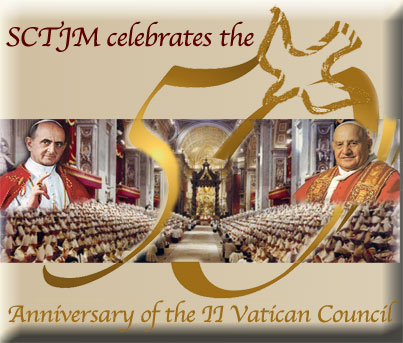St. John XXIII surprised the Church and the world with the convocation to celebrate the II Vatican Council. Blessed John XXIII could only attend the first session of the Council. Pope Paul VI received the legacy of bringing "the great grace bestowed on the Church in the twentieth century" (NMI #57) to a successful conclusion. He asks us: "May the council be read, reread, studied, assimilated, integrated, in the bimillenial ecclesial tradition, result in attitudes, behaviors, and institutions." (Paul VI, September 1966 to the Congress of Theology on the Theology of Vatican II). |

![]()
St. John XXIII provoked general surprise in the world on January 25, 1959. He announced his intention to convoke a council for the Universal Church. Without having very concrete ideas about the content of the council, Bl. John XXIII identified two objectives: an adaptation (aggiornamento) of the Church and of apostolate to a world undergoing great transformation, and a return to unity among Christians, which seems to be what the Pope thought would happen shortly. The council did not speak so much of the Church fighting against adversaries as it did of finding a way of expression in the world in which she lived and seemed to ignore.
Vatican II was an ecumenical council that took place in Vatican City from October 11, 1962, until December 8, 1965. This council represents a major event in the life of the Church of the 20th century, and for this reason it constitutes a fundamental era in universal history. It came to be the conclusion of the Tridentine period and the beginning of a new phase in the history of the Church. This is due to the prophetic action of Bl. John XXIII who perceived the need for a council that would positively mark the new phase of the Church's evangelizing mission and to the undisputed personality of Paul VI who had the courage to have brought it to its conclusion and to have forged the first steps of reform.
From January 25, 1959, in the Basilica of St. Paul's Outside the Walls, a double movement was initiated: on one hand direct preparation for the council began, accomplished above all by the Roman Curia; on the other, the separation of diverse eccesial experiences that tended toward a strong renewal of the life of the Church. A look at preconciliar history clearly reveals the existence of a strong conservative block; different factors testify to it; we can recall in particular: the concentration of the Curia and the vacant office of the Secretary of State that Pius XII always held; the different condemnations of several theological renovations; the prohibition against teaching what was held by different valuable professors, like H. de Lubac, Y. Congar, Teilhard de Chardin..., after the publication of Humani Generis. Different factors already suggested the change that soon become reality; the socio-cultural context already showed the signs of an irreversible industrialization: the countries of the Third World assumed an identity that they had never before had and colonialism was reaching its end; in a word: society was fearfully and something was being conceived that would modify more than just civil life.
There were also signs within the Church that signaled change: the ecumenical movement continued to grow with a strong consciousness of creating authentic spaces for encounter and dialogue; the laity assumed an appearance of authentic ecclesial maturity; the theological context seemed to be sustained by an investigation that returned to the genuine sources of Scripture and the Fathers. The preparatory commission was presided over by Cardinal Tardini; the Secretary General of the council was Bishop Pericles Felici; the material for discussion was prepared by ten commissions composed of various theologians from the Curia and was set out in 70 schema. The majority of the people involved in the preparation of the Council began with the assurance that it would conclude in a few months; unfortunately, these presentiments were inaccurate. In three years of intense work, the council rejected a great part of the preparatory material and formulated some documents that restored an authentically Evangelical horizon to the Church. There were 2,540 bishops present at the Council, coming from every continent, as were at least 480 theologians - "peritos" and auditors -, thus as representatives of reform and orthodoxy. This representation manifested the new expressions of dialogue that had been codified in the documents themselves. Vatican II, a point of change for the pontificate of Bl. John XXIII revolutionized the position of the Catholic Church regarding the ecumenical movement. The ecumenical concern was, in the mind of Pope John XXIII, one of the principle stimuli that had brought him to announce his intention to call a council "to manifest, to a greater degree, our love and benevolence toward those who call themselves Christians but are separated from the Apostolic See, so that they also can closely follow the works of the council and thus more easily find the way to achieve unity for which Jesus directs to the Heavenly Father such an ardent plea."
The celebration of the council constituted a great event for all Christianity. The presence of non-Catholic observers and their collaboration through questions and observations contributed by introducing an ecumenical dimension to the conciliar documents. As such, the occurence of the council was for all churches, during those years, a sign of hope. It made manifest the possibility that a Church would begin and bring to a good conclusion, in a certain sense, a general updating and reform. It also made for an admirable example of the concilar character of the Church. The concept of "council" was actualized, again, as much in the Orthodox churches as in the whole ecumenical movement,


